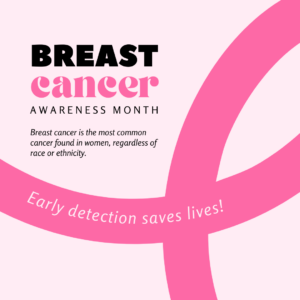
Positively Pittsburgh’s Guide to Area Breweries
September 28, 2023
Pittsburgh’s Italian Heritage
October 9, 2023
Mammograms Save Lives
Breast cancer prevention is something every woman should take control of, whether she’s young or old. It was April of 2020 when I had my first mammogram – I was 35. I felt a lump in my right breast. At first, I thought I was imagining it. Then my husband felt it when I asked him. And then my OBGYN felt it and immediately ordered a mammogram. Two days later, I was at Magee Womens Hospital, where I was told there was nothing to worry about, but that I should start to have mammograms due to familial history. This came as a shock since I had always been told that I didn’t need to worry, since I didn’t have first degree relatives with it.
According to the CDC, if a woman has a first-degree relative (mother, sister, or daughter) she is at higher risk of developing breast cancer. But she also has an elevated risk if she has multiple family members on either side of her family who have had breast or ovarian cancer.
A lot of the conversation about increased breast cancer risk has surrounded BRCA1 and BRCA2. When I was tested for these and they came back negative, I thought I had nothing to worry about. Nobody had mentioned the increased risk from multiple family members having breast cancer. Yet, something in my gut told me to be concerned. The odds just didn’t seem favorable.
The Second Mammogram
When I went in for my second mammogram, I was there for hours. They kept requesting more and more images. I knew this couldn’t be a good sign. They don’t ask for more images because there’s nothing there. Clearly, there was something they were trying to see. At this time, I was sitting alone in the mammogram hallway at Magee. I didn’t know it, but while men are allowed to be your support person, they’re not actually allowed back in the hallway.
So, there I sat, in the cold hallway in my pale pink gown, worried that I was going to be told I had cancer. I kept trying to keep calm, but my tears were welling up. This was it. I knew it had to be it. The mammogram tech and I were talking, and I said, “If it’s cancer, or precancer, I’m getting rid of them. They’ve served their purpose.” She informed me that lots of young women are going that route now, and it’s not a bad way to go. After all, breast cancer prevention is better than doing nothing at all.
Finally, the radiologist called my husband and I into the room where she was analyzing the images. On the screen, it looked like a black and white nebula with clusters of tiny, speckled stars, with some outliers in the mix. If I wasn’t worried about something trying to kill me, it would be pretty. But those tiny clusters, it turns out, can be deadly. Crystals, or calcifications (I prefer to call them crystals; it sounds prettier) can turn into breast cancer and require monitoring. And I had so many it would be hard to monitor them all.
“I can’t send you for 20 biopsies,” she said. Her tone matter of fact. I’m sure in her line of work, she must be like that – curt, but with a sense of warmth under the surface. With 1 in 8 women in the United States having the chance to develop breast cancer, she probably has to distance herself to be able to survive.
A Change in Screening
This appointment changed the trajectory of my screenings. She recommended I speak to genetics and then high-risk. And due to my family history, I was behind on my screenings; I should have been getting regular mammograms for years at this point. According to the NIH, women with a strong familial history of breast cancer should start to receive mammograms 10 years before the age of their youngest relative who was diagnosed. After all, early detection is key, and breast cancer prevention requires diligence.
Last year, my doctors recommended I start to receive breast MRIs, since they can capture things that mammograms can miss. My first was in May 2023. At this point in time, breast screenings were old hat. I had a routine and a friend who could come and sit with me during the waiting. It was nice to have a distraction, and a science nerd who liked stats, with me. Unfortunately, this MRI didn’t come back clean. There was a “very low suspicion” spot, and I needed a biopsy.
I took part in Magee’s dye-enhanced mammogram led breast biopsy study. The results came back one evening, with no one to decipher them. But I knew “atypical” wasn’t good. I reached out to all my medical friends, and they all told me none of the words were cancer. But something felt off. It felt like everyone was avoiding telling me something bad. Like, they didn’t want to deliver the news. The next day, I was told that I had precancerous cells and needed to follow up with a breast surgeon. I knew what this meant. I’d heard this before from other people, who eventually got breast cancer. This was the start. I could either wait and see if I get breast cancer, or I could take control of the situation.
Knowing My Personal Statistics
After speaking with my care team, I have decided to get a bilateral mastectomy with reconstruction, and luckily my insurance will cover it since they found atypical cells. I can’t continue to go in three times a year and wait in the hallway in the pink gown, wondering if this time is it. They don’t increase screening because they’re not concerned, they increase the screenings because there’s the chance the cells mutate into little killing machines. Even before I met with high risk and learned my odds of developing breast cancer are a whopping 39.4%, I knew this was the right choice for me. Some women opt to continue screening, but that was not for me.
Women need to be aware of their odds. Facts and percentages help us to understand what we’re up against and will help us to plan our breast cancer prevention strategies. For women who have lower odds, there are other options that might work better for them. Unfortunately, that’s not in the cards for me, and that’s okay.
I’m grateful that we live in Pittsburgh now, where there is an amazing health system through UPMC that’s focused on women’s health, and breast cancer. If I had waited until the recommended age of 40, who knows how this story would have turned out. For any women who are concerned about their breast health, they should absolutely speak to their providers. If you feel even the tiniest of lumps, get it checked. My lump that disappeared is in the exact same area where the atypical cells were. I can’t explain how that happened, but I don’t need to.
by Bianca Labrador
***
If you would like to read more stories about Pittsburgh and the role of many in the community to help those in the fight and breast cancer prevention, you can find more articles here.




